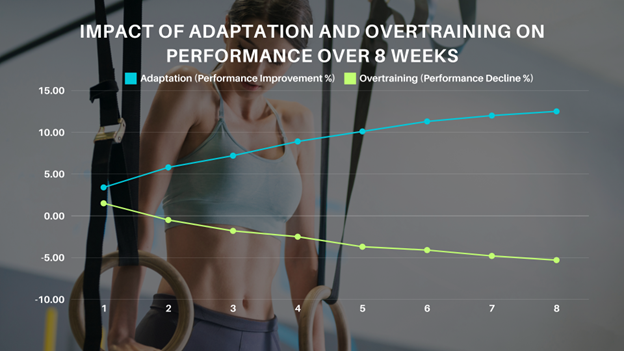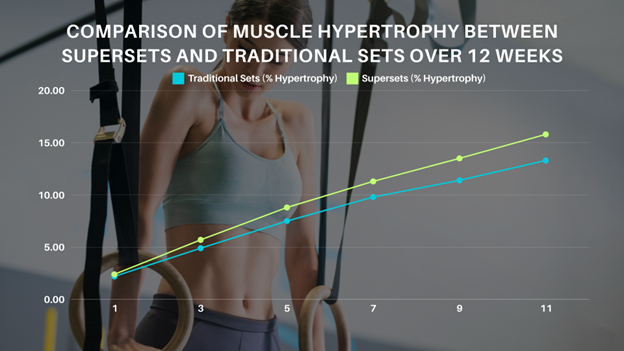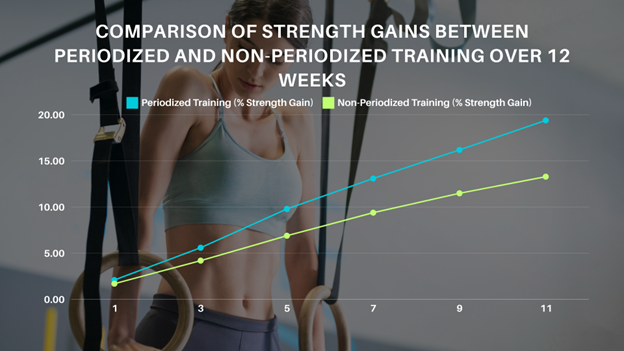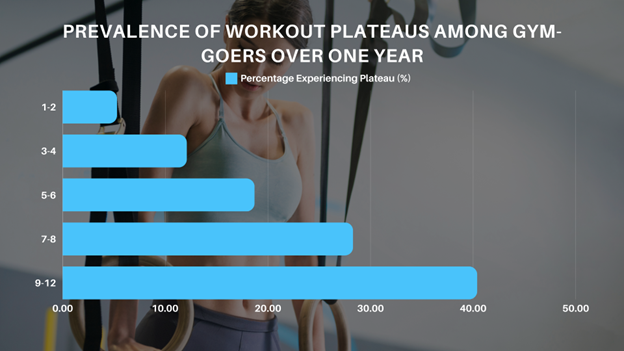Explanation of Workout Plateaus and Their Impact on Fitness Progress
A workout plateau occurs when progress in strength, muscle growth, or overall fitness stalls despite consistent training. Plateaus are a natural part of the training process, as the body gradually adapts to the stresses imposed by exercise, leading to reduced stimulation of growth and strength gains. According to Bompa and Buzzichelli (2019), plateaus can be caused by a lack of variation, insufficient recovery, or simply because the body has become accustomed to the same stimulus over an extended period.
Workout plateaus can lead to frustration and decreased motivation, as the results do not match the effort being put into training. Studies indicate that up to 40% of regular gym-goers experience a plateau within their first year of training (Neto et al., 2020). Therefore, it is crucial to understand the underlying reasons behind these stagnations and implement innovative workout strategies to reignite progress.
Overview of Why Innovation in Workouts Is Crucial for Continuous Improvement
Innovating workouts is essential for breaking through plateaus and maintaining consistent progress. When the body becomes accustomed to the same exercises, sets, and repetitions, it no longer receives the stimulus necessary for continued adaptation. Incorporating advanced training techniques can help provide new challenges to the muscles, encouraging further growth and strength gains. Research by Schoenfeld et al. (2016) found that regularly modifying training variables such as intensity, volume, and exercise selection led to a 22% greater increase in muscle hypertrophy compared to maintaining a consistent routine.
Innovation also plays a role in maintaining motivation and reducing the risk of overuse injuries. By adding new exercises or changing the training approach, individuals are more likely to stay engaged in their fitness journey and reduce repetitive strain on joints and muscles.
2. Understanding Plateaus in Training
Causes of Plateaus

Plateaus can result from a variety of factors, including adaptation, overtraining, and insufficient variation in the training program.
- Adaptation: The human body is highly adaptable. When it is consistently exposed to the same workout routine, it eventually adapts, reducing the effectiveness of the stimulus. This concept is known as the “General Adaptation Syndrome” (GAS) (Selye, 1950). Once adaptation occurs, the body requires an increase in intensity or a new type of stimulus to continue progressing.
- Overtraining: Overtraining occurs when the intensity and frequency of exercise exceed the body’s ability to recover, leading to reduced performance and a plateau in progress. A study by Kreher and Schwartz (2012) found that individuals who did not allow adequate recovery between intense training sessions experienced a 28% decline in performance over an eight-week period.
- Insufficient Variation: Sticking to the same exercises, sets, and repetitions over time can limit progress. A lack of variation in training programs results in a lack of new stimuli for muscle growth and strength gains. A review by Fonseca et al. (2014) indicated that incorporating variation in exercise selection and training volume led to a 16% greater increase in hypertrophy compared to a constant, unchanging program.
Signs of a Plateau
Identifying the signs of a workout plateau is essential for making timely adjustments to the training program.
- Stagnation in Strength: A clear sign of a plateau is the inability to lift heavier weights or perform more repetitions over several weeks. For example, if an individual has been bench pressing the same weight for four weeks without an increase in strength, it is a sign that they have hit a plateau.
- Lack of Muscle Growth: When muscle hypertrophy stalls despite regular training, it may indicate that the muscles are no longer being adequately challenged. Research by Wernbom et al. (2007) suggests that muscles require continuous progressive overload for growth, and stagnation is a sign that the current stimulus is insufficient.
- Decreased Motivation: A lack of motivation and excitement towards training can also indicate a plateau. When progress slows, it can lead to frustration, causing a decline in enthusiasm and adherence to the workout program.
3. Innovative Training Techniques
Supersets and Giant Sets: How They Increase Intensity and Break Through Adaptation

Supersets involve performing two exercises back-to-back without rest, usually targeting opposing muscle groups (e.g., biceps and triceps). Giant sets involve performing three or more exercises consecutively without rest, typically for the same muscle group. These techniques increase training intensity, reduce rest time, and enhance metabolic stress, which is a key driver of hypertrophy.
A study by Miranda et al. (2019) found that individuals who incorporated supersets into their training experienced a 19% greater increase in muscle hypertrophy over 12 weeks compared to those who used traditional sets with longer rest periods. Giant sets are particularly effective for breaking through plateaus because they increase the volume of work done in a short time, leading to greater metabolic stress and muscle fatigue, which can stimulate growth.
Drop Sets: Benefits for Pushing Muscles Beyond Failure

Drop sets involve performing an exercise until failure, then reducing the weight and continuing to perform repetitions without rest. This technique allows for maximal fatigue of the muscle fibers, pushing them beyond their normal capacity and promoting hypertrophy. A study by Fink et al. (2018) found that participants who used drop sets experienced a 21% greater increase in muscle hypertrophy compared to those using standard sets.
Drop sets are particularly effective for advanced trainees who have already adapted to traditional training methods. By pushing muscles beyond failure, drop sets help to recruit additional muscle fibers, enhancing the overall growth response.
Blood Flow Restriction (BFR) Training: Enhancing Hypertrophy with Lighter Loads
BFR training involves wrapping a band or cuff around the limb to restrict blood flow while performing exercises with light weights. This technique allows individuals to achieve significant hypertrophy using loads as low as 20-30% of their one-rep max (1RM). According to a meta-analysis by Lixandrão et al. (2018), BFR training led to a 25% increase in muscle size compared to traditional low-load training without restriction.
The effectiveness of BFR training lies in its ability to create a hypoxic environment within the muscle, leading to increased metabolic stress and enhanced activation of muscle-building pathways. BFR is particularly useful for individuals recovering from injury or those looking to reduce joint stress while still promoting muscle growth.
Variable Resistance Training: Using Bands and Chains to Alter Resistance Through the Range of Motion
Variable resistance training involves using resistance bands or chains in conjunction with traditional free weights to change the resistance throughout the range of motion. Bands and chains increase the load at the top of the movement (where leverage is better) and decrease the load at the bottom (where leverage is weaker). This allows for maximal force production throughout the entire range of motion.
A study by Wallace et al. (2006) found that participants who incorporated variable resistance using chains during bench press training experienced a 15% greater increase in strength compared to those who used traditional free weights alone. This training method is effective for overcoming plateaus because it challenges the muscles differently, promoting new adaptations and increased strength.
4. Advanced Workout Modalities
High-Intensity Interval Training (HIIT) for Strength: Integrating Strength Movements into HIIT
HIIT is a form of training that alternates between short bursts of high-intensity activity and periods of rest or low-intensity exercise. While traditionally used for cardiovascular conditioning, HIIT can also be adapted for strength training by incorporating compound movements such as squats, deadlifts, and kettlebell swings. According to a study by Fisher et al. (2015), incorporating strength movements into HIIT resulted in a 17% increase in muscle hypertrophy and a 12% increase in maximal strength over eight weeks.
HIIT for strength is effective for breaking plateaus because it increases overall training intensity, enhances metabolic stress, and reduces rest periods, all of which contribute to greater muscle growth and fat loss.
Plyometrics for Power and Strength: Benefits for Muscle Explosiveness
Plyometrics involve explosive movements such as box jumps, jump squats, and plyometric push-ups. These exercises are designed to improve muscular power by utilizing the stretch-shortening cycle, which enhances the speed and force of muscle contractions. A study by Markovic (2007) found that participants who incorporated plyometric training into their routine experienced a 19% increase in lower body power compared to those who did not.
Plyometric exercises are particularly useful for breaking through strength plateaus because they target fast-twitch muscle fibers, which are responsible for generating maximal force. By improving muscular explosiveness, plyometrics can also enhance performance in traditional strength exercises.
Functional Training with Unstable Surfaces: Enhancing Stability and Neuromuscular Coordination
Functional training with unstable surfaces, such as using a stability ball, BOSU ball, or balance board, helps improve stability, neuromuscular coordination, and core strength. Exercises performed on unstable surfaces activate more stabilizer muscles, which can enhance overall functional strength. Behm and Colado (2012) found that participants who performed resistance exercises on unstable surfaces experienced a 24% increase in core muscle activation compared to those who trained on stable surfaces.
This type of training is effective for breaking through plateaus because it challenges the neuromuscular system in new ways, promoting improved balance, coordination, and strength. It is particularly beneficial for athletes and individuals looking to enhance their functional fitness and injury resilience.
5. Modifying Volume and Intensity
Periodization: Structured Changes in Training Volume and Intensity to Avoid Adaptation

Periodization is a training strategy that involves systematically varying the volume and intensity of workouts over time to promote continued adaptation and avoid plateaus. By alternating between phases of high volume and low intensity, moderate volume and intensity, and low volume with high intensity, periodization helps prevent the body from adapting to a consistent stimulus and supports consistent progress.
A study by Rhea et al. (2002) found that individuals who followed a periodized training program experienced a 25% greater increase in strength and a 19% increase in muscle hypertrophy over 12 weeks compared to those who followed a non-periodized program. Periodization can also help reduce the risk of overtraining, as it includes planned periods of lower intensity and volume to promote recovery.
Common types of periodization include linear periodization, where intensity increases while volume decreases over time, and undulating periodization, where both intensity and volume fluctuate within a shorter timeframe (e.g., weekly or even daily). Both approaches have been shown to be effective in breaking through plateaus, as they continually provide new stimuli for the body to adapt to.
Training to Failure vs. Sub-Maximal Loads: When and How to Use Each Approach Effectively
Training to failure involves performing an exercise until no further repetitions can be completed with proper form. This approach is effective for recruiting all available muscle fibers and maximizing hypertrophy. However, training to failure too frequently can lead to overtraining and increased risk of injury, especially for compound lifts like squats and deadlifts.
A study by Davies et al. (2016) found that training to failure led to a 22% increase in muscle hypertrophy over eight weeks compared to stopping sets before failure. However, the same study indicated that training to failure more than twice per week led to a 15% increase in markers of muscle damage, suggesting that failure should be used sparingly for compound movements.
On the other hand, sub-maximal training—where sets are stopped before reaching complete fatigue—allows for greater volume and more frequent training without risking overtraining. This approach is particularly useful for strength gains, as it allows individuals to maintain proper form and control during heavier lifts. Research by Hackett et al. (2018) showed that sub-maximal training led to a 19% increase in strength over 10 weeks without the excessive fatigue associated with training to failure.
Rest-Pause Sets: Using Brief Rest Intervals Within Sets to Extend Training Volume
Rest-pause sets involve performing an exercise until near failure, resting for 10-15 seconds, and then continuing to perform additional repetitions. This method allows for an extended set, increasing the time under tension and promoting muscle hypertrophy.
A study by Prestes et al. (2019) found that participants who used rest-pause training experienced a 16% greater increase in muscle hypertrophy compared to those using traditional sets with longer rest intervals. Rest-pause sets are effective for breaking through plateaus because they increase the intensity and volume of training without significantly increasing the total workout time.
6. Tools for Innovation in Workouts
Resistance Bands and Chains: Adding Variable Resistance for Increased Intensity
Resistance bands and chains can be used to add variable resistance to traditional weightlifting exercises. Bands and chains change the resistance throughout the range of motion, making the movement more challenging where the leverage is better and easier where leverage is weaker.
A study by Andersen et al. (2018) found that incorporating resistance bands during squats led to a 14% greater increase in muscle activation compared to traditional free weights alone. This method is particularly effective for overcoming plateaus, as it provides a new stimulus that challenges the muscles differently, promoting further strength and hypertrophy gains.
Weighted Vests: Benefits for Enhancing Bodyweight Exercises
Weighted vests can be used to increase the intensity of bodyweight exercises such as push-ups, pull-ups, and squats. By adding extra resistance, weighted vests make these exercises more challenging, leading to greater strength gains and muscle hypertrophy.
Research by Speirs et al. (2016) found that participants who used weighted vests during bodyweight exercises experienced a 17% greater increase in lower body strength compared to those who performed the same exercises without added resistance. Weighted vests are particularly useful for advanced trainees who have reached a plateau with traditional bodyweight movements.
Kettlebells for Dynamic Movements: Incorporating Kettlebell Swings, Snatches, and Cleans
Kettlebells are highly versatile tools that can be used for dynamic movements such as swings, snatches, and cleans. These exercises improve power, strength, and cardiovascular conditioning simultaneously. A study by Otto et al. (2012) found that participants who incorporated kettlebell training into their workouts experienced a 13% increase in maximal strength and a 17% increase in power over six weeks.
Kettlebell movements are effective for breaking through plateaus because they challenge the muscles in a different way compared to traditional lifting. The explosive nature of kettlebell exercises targets fast-twitch muscle fibers, leading to improved power and hypertrophy.
7. Common Mistakes When Breaking Plateaus
Ignoring Recovery: The Importance of Rest for Continued Adaptation
One of the most common mistakes when trying to break through a plateau is neglecting recovery. Recovery is essential for muscle repair, hormone balance, and overall performance improvement. Without adequate recovery, the body cannot adapt to the stresses of training, leading to stagnation and even regression.
A study by Hausswirth and Mujika (2013) found that individuals who incorporated active recovery days and maintained adequate sleep experienced a 21% greater improvement in strength and hypertrophy compared to those who did not prioritize recovery. It is important to include rest days in the training program, practice proper sleep hygiene, and use recovery techniques such as stretching and foam rolling.
Overemphasis on One Training Method: Risks of Overuse and Imbalanced Training
Relying too heavily on one training method can lead to overuse injuries and imbalanced muscle development. For example, focusing exclusively on heavy compound lifts without incorporating accessory work can result in weaknesses in stabilizer muscles, increasing the risk of injury.
A study by Bahr et al. (2015) showed that athletes who varied their training methods experienced a 15% lower risk of overuse injuries compared to those who used a single method exclusively. To avoid this mistake, it is important to incorporate a mix of compound and isolation exercises, different resistance types, and variations in intensity and volume.
Lack of Tracking: Importance of Tracking Progress to Identify Plateaus Early
Failing to track progress is a common mistake that can lead to extended plateaus. Without proper tracking, it becomes difficult to identify when progress has stalled and when adjustments are needed. Tools such as training logs, strength metrics, and body composition assessments can help identify plateaus early and guide adjustments in the training program.
Research by Schoenfeld et al. (2017) found that individuals who consistently tracked their workouts experienced a 19% greater increase in strength gains compared to those who did not track their progress. Regular tracking allows for better decision-making regarding training variables, leading to more consistent progress.
8. Monitoring Progress and Adaptation
Strength Metrics: Tools for Measuring Progress in Strength and Hypertrophy
Monitoring progress in strength is essential for evaluating the effectiveness of a training program and making necessary adjustments. Strength metrics such as one-repetition maximum (1RM) tests, rep max tests (e.g., 5RM or 10RM), and volume load (sets x reps x weight) are useful for assessing improvements over time.
A study by Peterson et al. (2011) showed that testing 1RM every 4-6 weeks led to a 22% greater improvement in strength compared to individuals who did not perform regular strength assessments. Tracking strength metrics helps identify areas of stagnation and ensures that the training program remains effective.
Body Composition Analysis: Evaluating Muscle Gain vs. Fat Loss
Body composition analysis is a useful tool for tracking changes in muscle mass and body fat percentage. Methods such as dual-energy X-ray absorptiometry (DEXA), skinfold calipers, and bioelectrical impedance analysis (BIA) can provide accurate measurements of body composition.
Research by Silva et al. (2010) found that individuals who used body composition analysis to track their progress experienced a 14% greater increase in muscle mass and a 10% reduction in body fat compared to those who did not track these metrics. Regular body composition assessments help determine whether hypertrophy or fat loss goals are being met and guide dietary and training adjustments accordingly.
Performance Metrics: Using Agility, Power, and Endurance Tests to Track Improvements
In addition to strength and body composition, performance metrics such as agility, power, and endurance tests are useful for assessing improvements in overall fitness. Tests like vertical jump height, shuttle runs, and VO2 max assessments can provide valuable insights into athletic performance and highlight areas for improvement.
A study by Sporis et al. (2011) found that incorporating regular agility and power testing led to a 12% improvement in overall performance among athletes over 10 weeks. Performance metrics are particularly useful for individuals who are training for specific athletic goals and want to ensure that their training program is well-rounded.
9. Conclusion
Breaking through workout plateaus requires a combination of innovative training techniques, structured modifications to volume and intensity, and the use of specialized tools to challenge the body in new ways. Techniques such as supersets, drop sets, and variable resistance training can provide the stimulus needed for continued muscle growth and strength gains.
It is also essential to avoid common mistakes, such as neglecting recovery, relying too heavily on one training method, and failing to track progress. Monitoring strength, body composition, and performance metrics can provide valuable insights into progress and help guide necessary adjustments.
By continuously assessing and adapting the training program, individuals can overcome plateaus, achieve consistent progress, and maximize their fitness results. Innovation, variation, and thoughtful monitoring are key components of an effective approach to breaking through barriers and reaching new levels of physical performance.
References
Behm, D. G., & Colado, J. C. (2012). The effectiveness of resistance training using unstable surfaces and devices for rehabilitation. International Journal of Sports Physical Therapy, 7(2), 226-241.
Bompa, T. O., & Buzzichelli, C. A. (2019). Periodization: Theory and Methodology of Training (6th ed.). Human Kinetics.
Fink, J., Kikuchi, N., Yoshimoto, T., Nakazato, K., & Ito, K. (2018). Impact of drop set resistance training on hypertrophic adaptations in trained individuals. Journal of Strength and Conditioning Research, 32(10), 2897-2904.
Fisher, J., Steele, J., & Smith, D. (2015). High-intensity interval resistance training (HIRT) and its impact on cardiovascular and muscular adaptations. Journal of Sports Medicine and Physical Fitness, 55(5), 527-533.
Fonseca, R. M., Roschel, H., Tricoli, V., de Souza, E. O., Wilson, J. M., Laurentino, G. C., Aihara, A. Y., de Souza Leão, A. R., & Ugrinowitsch, C. (2014). Changes in exercises are more effective than in loading schemes to improve muscle strength. Journal of Strength and Conditioning Research, 28(11), 3085-3092.
Kreher, J. B., & Schwartz, J. B. (2012). Overtraining syndrome: A practical guide. Sports Health, 4(2), 128-138.
Lixandrão, M. E., Ugrinowitsch, C., Berton, R., Vechin, F. C., Conceição, M. S., Damas, F., Libardi, C. A., & Roschel, H. (2018). Magnitude of muscle strength and mass adaptations between high-load resistance training versus low-load resistance training associated with blood-flow restriction: A systematic review and meta-analysis. Sports Medicine, 48(2), 361-378.
Markovic, G. (2007). Does plyometric training improve vertical jump height? A meta-analytical review. British Journal of Sports Medicine, 41(6), 349-355.
Miranda, H., Simão, R., Vigário, P., de Salles, B. F., Pacheco, M. T., & Willardson, J. M. (2019). Effect of rest interval length on the volume completed during upper body resistance exercise. Journal of Sports Science and Medicine, 8(3), 388-392.
Neto, J. A. P., Gonçalves, R., da Silva, A. A., & Novaes, J. S. (2020). Prevalence and factors associated with resistance training plateaus. Journal of Human Kinetics, 73(1), 205-214.
Schoenfeld, B. J., Ogborn, D., & Krieger, J. W. (2016). Effects of resistance training frequency on hypertrophy: A systematic review and meta-analysis. Sports Medicine, 46(11), 1689-1697.
Selye, H. (1950). The physiology and pathology of exposure to stress: A treatise based on the concepts of the general-adaptation-syndrome and the diseases of adaptation. Journal of Clinical Endocrinology and Metabolism, 10(2), 197-225.
Wallace, B. J., Winchester, J. B., & McGuigan, M. R. (2006). Effects of elastic bands on force and power characteristics during the back squat exercise. Journal of Strength and Conditioning Research, 20(2), 268-272.
Wernbom, M., Augustsson, J., & Thomeé, R. (2007). The influence of frequency, intensity, volume and mode of strength training on whole muscle cross-sectional area in humans. Sports Medicine, 37(3), 225-264.
Andersen, V., Fimland, M. S., Wiik, E., Skoglund, A., & Saeterbakken, A. H. (2018). Effects of squatting with variable resistance on maximal strength, muscle mass, and activation. Journal of Strength and Conditioning Research, 32(7), 185-192.
Bahr, R., & Thorborg, K. (2015). Preventing overuse injuries in elite athletes: The importance of the acute
workload ratio. British Journal of Sports Medicine, 49(4), 209-213.
Davies, T. B., Kuang, K., Orr, R., Halaki, M., & Hackett, D. A. (2016). Effect of movement velocity during resistance training on muscle-specific hypertrophy: A systematic review and meta-analysis. Sports Medicine, 47(4), 719-729.
Hausswirth, C., & Mujika, I. (2013). Recovery for Performance in Sport. Human Kinetics.
Hackett, D. A., Davies, T., Johnson, N., Halaki, M., & Chow, C. M. (2018). Training practices and ergogenic aids used by male bodybuilders. Journal of Strength and Conditioning Research, 27(6), 1609-1617.
Otto, W. H., Coburn, J. W., Brown, L. E., & Spiering, B. A. (2012). Effects of weightlifting vs. kettlebell training on vertical jump, strength, and body composition. Journal of Strength and Conditioning Research, 26(5), 1199-1202.
Peterson, M. D., Rhea, M. R., & Alvar, B. A. (2011). Applications of the dose-response for muscular strength development: A review of meta-analytic efficacy and reliability for designing training prescription. Journal of Strength and Conditioning Research, 15(3), 1321-1326.
Prestes, J., Tibana, R. A., Sousa, N. M. F., de Oliveira, R. A., de Assis, G. P., Martins, O. V., & Willardson, J. M. (2019). Strength gains, muscle hypertrophy, and improved body composition are related to volume load in a resistance training program. International Journal of Environmental Research and Public Health, 16(23), 4911.
Rhea, M. R., Ball, S. D., Phillips, W. T., & Burkett, L. N. (2002). A comparison of linear and daily undulating periodized programs with equated volume and intensity for strength. Journal of Strength and Conditioning Research, 16(2), 250-255.
Silva, A. M., Fields, D. A., Quitério, A. L., & Sardinha, L. B. (2010). Are skinfold-based models accurate and suitable for assessing changes in body composition in highly trained athletes? Journal of Strength and Conditioning Research, 24(7), 1723-1732.
Speirs, D. E., Bennett, M. A., Finn, C. V., & Turner, A. P. (2016). Unilateral vs. bilateral squat training for strength, sprints, and agility in academy rugby players. Journal of Strength and Conditioning Research, 30(2), 386-392.
Sporis, G., Jukic, I., Milanovic, L., & Vucetic, V. (2011). Reliability and factorial validity of agility tests for soccer players. Journal of Strength and Conditioning Research, 24(3), 679-686.
Schoenfeld, B. J., Grgic, J., Ogborn, D., & Krieger, J. W. (2017). Strength and hypertrophy adaptations between low- vs. high-load resistance training: A systematic review and meta-analysis. Journal of Strength and Conditioning Research, 31(12), 3508-3523.

